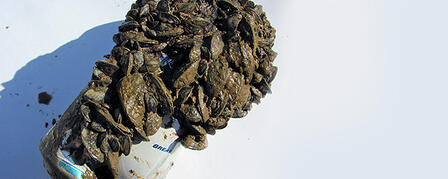ZEBRA MUSSELS FOUND IN TWO KANSAS LAKES

Sept. 5, 2013
Glen Elder Reservoir (Waconda Lake) and Lake Wabaunsee have the invasive species
TOPEKA – The Kansas Department of Wildlife, Parks and Tourism (KDWPT) has confirmed the presence of zebra mussels in Glen Elder Reservoir (Waconda Lake) in Mitchell County and Lake Wabaunsee in Wabaunsee County. Zebra mussels are bean-sized mollusks with striped, sharp-edged, two-part shells. Twenty-one Kansas lakes have now been confirmed to have zebra mussels.
“These latest discoveries show how important it is for the public to be aware of the dangers of aquatic nuisance species (ANS) and to take precautions to prevent their spread,” said Jessica Howell, KDWPT Aquatic Nuisance Species Coordinator.
There is no known method to rid a lake of zebra mussels. According to Howell, prevention is the best way to avoid spreading ANS. “By always cleaning, draining, and drying boats and other equipment and by not moving water around, we can stop the spread of not just zebra mussels, but most aquatic nuisance species that may be present,” she said.
The lakes will be added to the list of ANS-designated waters in Kansas, and notices will be posted at various locations around the lakes. The sharp-shelled zebra mussels attach to solid objects, so visitors should be careful when handling mussel-encrusted objects and when grabbing an underwater object when they can’t see what their hands may be grasping. Visitors should protect their feet when walking on underwater or shoreline rocks, a helpful precaution any time they are outdoors.
Zebra mussels are just one of the non-native aquatic species that threaten our waters and native wildlife. After using any body of water, boaters and anglers must remember to follow regulations and precautions that will prevent their spread:
- Clean, drain and dry boats and equipment between uses
- Use wild-caught bait only in the lake or pool where it was caught
- Do not move live fish from waters infested with zebra mussels or other aquatic nuisance species
- Drain livewells and bilges and remove drain plugs from all vessels prior to transport from any Kansas water on a public highway.
For more information about aquatic nuisance species in Kansas, report a possible ANS, or see a list of ANS-designated waters, visit ProtectKSWaters.org
ABOUT ZEBRA MUSSELS
Zebra mussels can produce huge populations in a short time and do not require a host fish to reproduce. A large female zebra mussel can produce 1 million eggs, and then fertilized eggs develop into microscopic veligers invisible to the naked eye. Veligers drift in the water for up to two weeks before they settle out as young mussels which quickly grow to adult size and reproduce during their first summer of life.
After settling, zebra mussels develop byssal threads that attach their shells to submerged hard surfaces such as rocks, piers, and flooded timber. They also attach to pipes, water intake structures, boat hulls, propellers, and submerged parts of outboard motors. As populations increase, they can clog intake pipes and prevent water treatment and electrical generating plants from drawing water. In 2012, two Kansas communities, Council Grove and Osage City, experienced temporary water shortages from zebra mussel infestations before water intake structures could be cleaned up. Removing large numbers of zebra mussels to ensure adequate water flow can be labor-intensive and costly.
Zebra mussels are native to the Black and Caspian seas of western Asia and eastern Europe and were spread around the world in the ballast water of cargo ships. They were discovered in Lake St. Clair and the Detroit River in 1988 and quickly spread throughout the Great Lakes and other rivers including the Mississippi, Illinois, Ohio, Tennessee, Arkansas and Hudson. In 2003, they were discovered in Kansas in El Dorado Reservoir. Despite public education efforts to alert boaters about the dangers of zebra mussels and how to prevent spreading them, the species continues to show up in new lakes every year. Moving water in boats and bait buckets has been identified as a likely vector.
For more information, contact Howell at (620) 342-0658 or by e-mail at jessica.howell@ksoutdoors.com.
-30-









